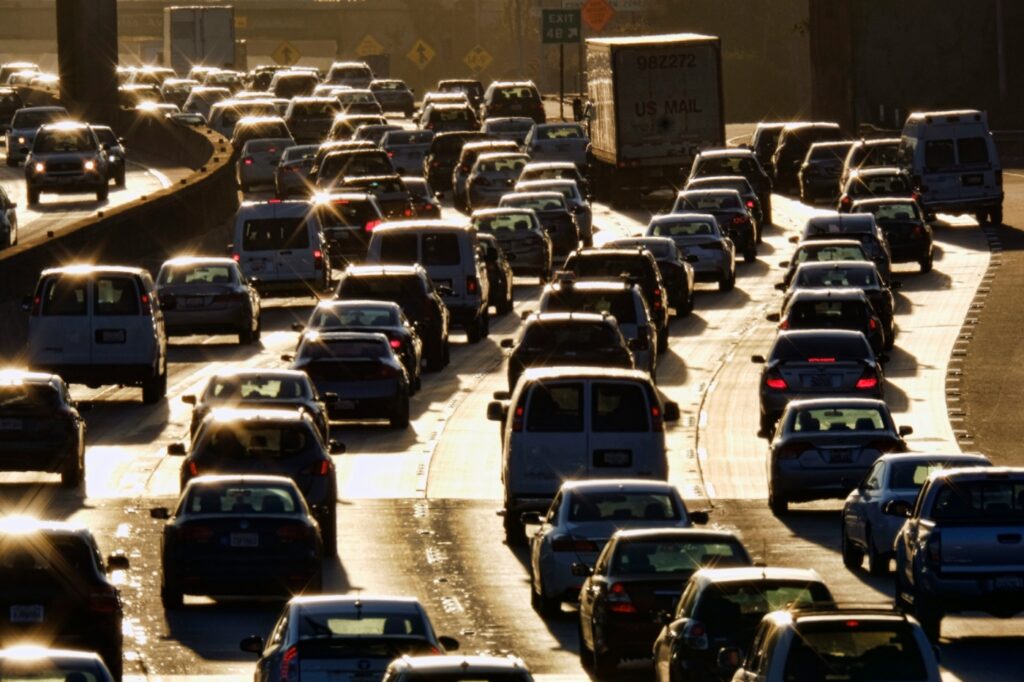
California today is built largely on a dream of the past. A century ago, when just 3.4 million people lived on plentiful and relatively cheap land, a sprawling landscape emerged enabled by the widespread ownership and use of cars. But now, nearly a dozen times as many people call the Golden State home, and the California dream is in danger of becoming a nightmare.
Today, most Californians have little choice in how to get around, as most places are designed to reward driving and punish its absence. Housing choices are dwindling as well, as most housing is single-family detached (with garages and driveways that often occupy more land than the house) and financially out of reach to more and more Californians each year. Most businesses are surrounded and separated from one another by publicly mandated parking lots. And much of the state is laced with noisy, polluting, and increasingly congested freeways, many of them cutting through disadvantaged communities.
The predictable result is that most people make most (over eight in 10) of their trips in cars, while those without them, who are disproportionately Black and Latino, are increasingly left behind. Policies favoring driving over other means of getting around have for decades received little scrutiny, even as many of our metro areas have grown to where traffic congestion is now endemic. It’s no wonder that the transportation sector accounts for more than 40 percent of all of the state’s greenhouse gas emissions, and cars for about three-quarters of that.
If we want more options to get around, more affordable housing choices, and to meet our climate goals, we need to change course. But how? As part of the California 100 Initiative, which aims to develop a vision and strategy for the state’s next century, colleagues and I at the UCLA Institute of Transportation Studies sifted through reams of data and research and spoke with a wide array of experts in the public and private sectors.
Our analysis found that California’s reliance on low-density, sprawling development, with its wide streets and freeways and ubiquitous free parking, requires most Californians to travel by car for almost all of their trips, whether or not they own a car or want to drive that much. Building primarily around the car consumes a lot of land, costs a lot of money, and generates a lot of emissions. Devoting so much developed land to parking takes it away from more productive uses, such as for providing much-needed housing. Indeed, our diverse panel of interviewed experts mostly called for metropolitan and transportation planning to become more urban-focused and shift to a less sprawling, car-dependent future.
What would such a shift entail? In the centers of the largest cities, we need to deemphasize cars by increasing commercial and housing densities, reducing or eliminating government parking mandates, and improving public transit. Driving should become one option among many, as more travelers will be able to easily walk and ride transit to nearby destinations. De-centering cars in central cities can make cities more sustainable, accessible, and lively places. And, if enough urban housing gets built, it will help make cities more affordable as well.
Beyond the state’s urban cores, suburbs will need to fill in rather than spread out further into fire-prone areas. Most people will continue to own cars and drive them in such places, but adding denser housing, improving walking and biking infrastructure, removing mandates that force developers to provide more parking than necessary (the high cost of which raises rents), and slowing traffic speeds can make it easier and safer for people to comfortably make at least some of their trips by means other than driving.
Even in small towns and rural areas, new developments should be constructed to make it easier for people to park once and walk to multiple destinations, rather than driving from parking lot to parking lot in developments strung along roadways. Innovations in rideshare and “on-demand” transit could offer residents travel options in such places as well.
But old habits die hard. Neighbors often oppose multi-unit housing proposals, fearing increased traffic, even as fewer and fewer Californians can afford detached single-family homes. Businesses often protest replacing street parking with dedicated lanes for transit buses, cyclists, or scooters, assuming (incorrectly) that their customers can only arrive via car. And public sector planners often require developers to “mitigate” traffic impacts by building plenty of parking and helping to fund nearby road expansions, which encourage yet more driving.
Related Articles
Newsom’s upbeat job picture vs. reality
Eastman and Trump assault the Constitution
Now is the time for California’s school districts to right-size and cut long-term costs
State Auditor needs to investigate water agency over inaccurate data
Should state house Ukrainian refugees?: Letters
It’s time for a new California dream. Instead of a one-size-fits-all model of land and transportation development, we need more travel choices and housing variety. We are over-reliant on driving in California, to the detriment of those who cannot afford to or do not have the ability to drive. All residents deserve to have easy ways of getting around.
Freeing Californians from having little choice but to live in places where driving is pretty much the only way to travel will create a more diverse, affordable, sustainable, and opportunity-rich California dream for the next century. Changing the patterns of the past century won’t happen overnight, but the better outcomes we hope to have achieved 30 years from now—with less land devoted to driving and parking, more land for housing, and more alternatives to driving—will be driven by the decisions we make (or fail to make) today.
Brian D. Taylor is Director of the UCLA Institute of Transportation Studies (ITS) and is a lead author of California 100’s Future of Transportation and Urban Planning Report on Policy and Future Scenarios. ITS Researchers John Gahbauer, Jacob Wasserman, and Juan Matute contributed to this piece.
